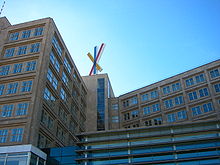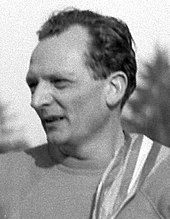Kurt Weidemann
Kurt Weidemann (born December 15, 1922 in Eichmedien , East Prussia / Masuria; † March 30, 2011 in Sélestat , Alsace ) was a German graphic designer , typographer , author and university lecturer.
Live and act
Weidemann's family moved from Masuria to Lübeck in 1926 . After completing his schooling at a national political educational institution , Kurt Weidemann was deployed as a war volunteer on the Eastern Front from 1940 and as a lieutenant in 1945 was taken prisoner by the Soviets, from which he was only released in 1950. Weidemann completed an apprenticeship as a typesetter in Lübeck from 1950 to 1952 and then studied four semesters of book graphics and typography with Walter Brudi at the State Academy of Fine Arts in Stuttgart from 1953 to 1955 . Weidemann has been a freelance graphic designer , advertising consultant and copywriter since 1955 . From 1955 to 1964 he was editor of the trade journal Der Druckspiegel .
In connection with the establishment of an institute for book design by the then rector Walter Brudi and the resulting expansion of the range of subjects offered, Kurt Weidemann was appointed artistic teacher for the newly introduced subject area “Information and graphic practice” with effect from May 1, 1964, at Brudi's suggestion appointed to the Stuttgart Academy. He was appointed professor "with an appointment as a civil servant for life" in 1965. However, without being entrusted with the management of a class of his own, he taught there until 1985. In 1968 he was committed to the revolting students; this went up to the assumption of legal fees in the circles of Klaus Croissant and Jörg Lang for legally concerned students and brought him conflicts with the rectorate and university senate. In the early 1980s he helped found the WHU - Otto Beisheim School of Management in Vallendar , where he taught from 1983.
In the early 1960s, Weidemann built the International Center for the Typographic Arts (ICTA) in New York City together with Aaron Burns and was its president from 1966 to 1972. From 1970 to 1972 he was President of the International Federation of Graphic Arts Associations ( Icograda ) ; He also directed the Stuttgart Künstlerhaus for 7 years.
In addition to his teaching position at WHU , he taught at the State University of Design in the Center for Art and Media in Karlsruhe from 1991 .
Kurt Weidemann was a close friend of Alfred Herrhausen , bank manager and board spokesman of Deutsche Bank , for over 15 years . In 1990, one year after his murder, Weidemann published a book with a selection of lectures and essays by Alfred Herrhausen.
Appearances
Weidemann revised or designed the corporate image of many well-known companies, including co op, Zeiss , Merck, Mercedes-Benz, Daimler-Benz, Deutsche Aerospace , Porsche and Deutsche Bahn. He also designed books for the Gutenberg Book Guild as well as the Ullstein , Propylaen , Ernst Klett and Thieme publishers .
co op, Merck and others (1960s)
In the 1960s, Weidemann designed the appearance of the co-op supermarkets ( in use at co-op AG until it was broken up in the 1980s, as the company logo of coop eG until 2004), Merck KGaA (in use until the 1990s), Behr GmbH & Co. KG ("Kühler-Behr"), the Nanz Group (a grocery chain store sold to the Edeka Group in 1996 ) and other companies.
Salem Boarding School (1974)
Kurt Weidemann also designed the logo for the renowned Salem boarding school on Lake Constance. His idea was to only use the name “Salem” as the logo and not add any explanatory text such as “Schule Schloss”. With this he gave the impetus for public relations and advertising in the boarding school, which he supported with many marketing ideas for over a decade.
Daimler-Benz (late 1980s)

After Weidemann had previously worked as an appraiser for Mercedes-Benz in questions of appearance , Edzard Reuter agreed to work with Weidemann as a consultant for the corporate identity of the group at the beginning of his work as CEO of Daimler-Benz AG in 1987 . In the course of this, all 52 typefaces used in the group up to then were replaced by Weidemann's Corporate ASE font family , which comprises a total of around 12,500 glyphs in the styles Antiqua , Sans Serif and Egyptienne .
Porsche (1990)
For the automobile manufacturer Porsche AG , Weidemann revised the coat of arms and the signature in 1990, the previous version of which he described as "lettering hit three times by the truck". In order to improve the readability of moving objects, opened Weidemann the punches of the letters P and R with the average height of the letters down, reinforced in R the inclined position of the right smear, reduced the stroke width in the legs of the letters E and S , shortened further in S the Length of the two legs and reduced the width of the H s. Because Porsche AG did not have enough money to pay Weidemann at the time, he received a car from the Carrera 4 series as a fee at his own request .
German Federal Railways (1993)
In 1993 the Deutsche Bundesbahn commissioned Weidemann to redesign the logo for the future Deutsche Bahn AG . He received a fee of 200,000 DM for the design of the new logo, based on the old Eduard Ege logo, including the final artwork required for the corporate design manual , which was generally criticized as excessive in the press reports on the project and in an article in Der Spiegel was also given in the wrong amount of 1.2 million DM.
By reversing the letters »DB« in the logo from negative (white in red) to positive (red in white), Deutsche Bahn saved after the introduction of the new logo - it was merged with the changeover to save further costs Stationery due to the introduction of the new German postcodes on July 1, 1993 - several hundred thousand DM per year alone in expenses for screen printing ink. For the same reason, Weidemann's design reduced the costs for embroidering the logos on the work clothing, calculated on the basis of the number of stitches, by almost half, from 1.59 DM to 0.89 DM per badge.
Weidemann's logo for Deutsche Bahn is similar to a label that the Deutsche Bundesbahn used in its early years on its buses (at the height of the front bumper and at the rear). This marking was replaced from the beginning of 1955 by the well-known Bundesbahn logo from Eduard Ege .
Bankgesellschaft Berlin (mid-1990s)

In the mid-1990s, Weidemann designed a logo for Bankgesellschaft Berlin consisting of three interlocking bars in the colors yellow, blue and red, for which he was criticized by one of the clients with the words: “But you didn't think of very much, Mr. Professor! "Weidemann countered him:" I'm particularly proud of that, a sign is good if you can scratch it in the sand with your big toe! "
Awards
- 1942–1945: Awarded the silver close combat clasp
- 1995: Lucky Strike Designer Award from the Raymond Loewy Foundation
- 1996: Federal Cross of Merit, 1st class
- 2006: Honorary Senator of the State Academy of Fine Arts in Stuttgart
Honorary memberships
- Württembergischer Kunstverein Stuttgart
- Association of Freelance Photo Designers (BFF)
- ADC Art Directors Club Germany
- AGD Alliance of German Designers
- DDC German Designer Club
- Künstlerhaus Stuttgart
Memberships
- since 1966 member of the Type Directors Club of New York and the Compagnon de Lure
- Member of the Alliance Graphique Internationale (AGI)
- since 1987 chairman of the Merz Akademie Stuttgart sponsorship association
- since 1991 member of the jury and chairman of the board of trustees of the Raymond Loewy Foundation
- since 2005 President of the dongxi German Chinese Design Forum
- since 2006 Honorary Senator of the State Academy of Fine Arts Stuttgart
plant
Font designs
- Biblica (1979), later renamed to
- ITC Weidemann (1983)
- Corporate ASE (1985–1989), designed by Kurt Weidemann as the corporate typeface of Daimler-Benz AG, final drawings by Kurt Strecker
- Klett Domus, corporate typeface for Ernst Klett Verlag
Publications
- Thinking_Ordnen_Gestalten: Alfred Herrhausen. Berlin 1990, ISBN 3-88680-399-6
- Perceive and find ideas. Seeing as a thought process . Wiesbaden 2004, ISBN 3-409-12679-1 .
- Kurt texts. Essays, interviews and speeches . 4th edition. AV edition. Stuttgart 1998, ISBN 3-929638-21-5 .
- Perceive, find ideas, give shape . Hatje / Cantz, Ostfildern-Ruit 2004, ISBN 3-7757-9167-1 .
- Where the letter leads the word. Views on writing and typography . 4th edition. Cantz, Ostfildern 2006, ISBN 3-89322-521-8 .
- Words and values . Schmidt, Mainz 2005, ISBN 3-87439-690-8 .
- Lack of words. In a race against thoughtfulness . Cantz, Ostfildern 1995, ISBN 3-89322-643-5 .
- Words. Put on the scales, put on the shovel . Hatje Cantz, Ostfildern-Ruit 2000, ISBN 3-7757-9037-3 .
- Hardly I, the field diaries and the imprisonment of Kurt Weidemann 1940–1950 . Kurt Weidemann 2002, OCLC 700310284 .
- Contributions and typographic supplements as editor of the trade journal Der Druckspiegel 1959 and in other design journals
Individual evidence
- ↑ Kurt Weidemann is dead. On: stuttgarter-zeitung.de , March 31, 2011.
- ↑ Wolfgang Kermer (Ed.): Between book art and book design: Book designer of the academy and former arts and crafts school in Stuttgart: examples of works and texts . Ostfildern-Ruit: Ed. Cantz, 1996 ISBN 3-89322-893-4 , pp. 159, 198.
- ^ Kurt Weidemann: Thinking, arranging, shaping: speeches and essays . WJ Siedler, Berlin 1990, ISBN 3-88680-399-6 .
- ↑ Kurt Weidemann. In: The Salem magazine. No. 58, July 2010, p. 33. (PDF on: salem-net.de ; 1.5 MB) ( Page no longer available , search in web archives ) Info: The link was automatically marked as defective. Please check the link according to the instructions and then remove this notice.
- ↑ Too many breast arches . In: Der Spiegel . No. 13 , 1994 ( online ). There, January 1, 1994 is given as the date of introduction.
- ^ Rail-Road-Bus 1954 before the rerailing ; See also illustrations in the Brekina book below on pp. 4, 11–13, 18–20, 23–25, 27–31, 34.
- ^ Volkhard Stern, Werner Hartung: The road vehicles of the German Federal Railroad. Part 1: Rail buses. (Brekina item no.11012). Brekina, Teningen 2003, p. 15.
- ( Bruns ) Tammo F. Bruns, Frank Schulte, Karsten Unterberger: design is a journey . Positions on design, advertising and corporate culture. Ed .: Hans Höger, German Design Council. Springer, Berlin / Heidelberg 1997, ISBN 3-540-61896-1 , pp. 98–113 (conversation with Kurt Weidemann on September 14, 1994).
- ↑ a b c d e p. 98.
- ↑ a b c p. 100 f.
- ↑ p. 105.
- ↑ a b p. 111.
- ↑ p. 112.
- ↑ a b c d p. 103.
- ↑ a b p. 104.
- ( Friedl ) Friedrich Friedl, Nicolaus Ott , Bernard Stein (eds.): Typography - when who how . Könemann, Cologne 1998, ISBN 3-89508-473-5 , p. 541-542 .
literature
- Petra Kiedaisch, Marc Feigenspan, Uli Cluss, Oliver-A. Krimmel (Ed.): "Dear ladies, gentlemen". The following spoke: Kurt Weidemann. av edition, Stuttgart 2008, ISBN 978-3-89986-097-9 .
- Uta Brandes (Ed.): Kurt Weidemann, The afterimage on the retina . Steidl, Göttingen 1996, ISBN 3-88243-394-9 .
- Tammo F. Bruns, Frank Schulte, Karsten Unterberger: design is a journey . Positions on design, advertising and corporate culture. Ed .: Hans Höger, German Design Council. Springer, Berlin / Heidelberg 1997, ISBN 3-540-61896-1 , pp. 98–113 (conversation with Kurt Weidemann on September 14, 1994).
- Wolfgang Kermer (Ed.): The professors of the graphic design, interior architecture and design departments . State Academy of Fine Arts Stuttgart, Stuttgart 1981.
- Wolfgang Kermer (Ed.): Between book art and book design: Book designer of the academy and former arts and crafts school in Stuttgart . Work examples and texts. Edition Cantz, Ostfildern-Ruit 1996, ISBN 3-89322-893-4 .
- Markus Merz (Ed.): Kurt Weidemann, Biographical Conversations with Heike Schiller & Arne Braun . Merz & Solitude, Stuttgart 2008, ISBN 978-3-937982-19-9 .
- Chris Schaal (Ed.): King and Fool - The Designer Kurt Weidemann . blaufisch, Stuttgart 2008, ISBN 978-3-00-023048-6 (book and film DVD).
Web links
- Literature by and about Kurt Weidemann in the catalog of the German National Library
- Information about Weidemann from the design consortium
- Information about Kurt Weidemann and his writings
- Type samples of three of his typefaces
- two short films and further reading or DVDs
- two conference recordings from TYPO Berlin in 1996 and 2008
- Film clips from the documentary King and Fool - The Designer Kurt Weidemann
- Kurt Weidemann in the Art Design Directory
- Obituary for Kurt Weidemann in the book market 04/2011
| personal data | |
|---|---|
| SURNAME | Weidemann, Kurt |
| BRIEF DESCRIPTION | German graphic designer, typographer, author and teacher |
| DATE OF BIRTH | December 15, 1922 |
| PLACE OF BIRTH | Calibration media , East Prussia , Masuria |
| DATE OF DEATH | March 30, 2011 |
| Place of death | Sélestat , Alsace |



